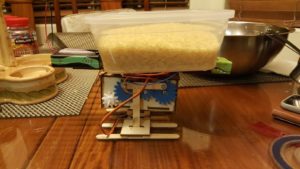Load Capacity Test
By Victoria Osaji, Manufacturing and Development Engineer
Table of Contents [hide]
Introduction:
This was another one of the four tests we conducted to demonstrate the mechanical capabilities of our robot dinosaur. In this test we are looking to determine the load the robot can sustain without any significant damage or falling apart. This way we know the limitations on the robot support so as not to damage any of the linkages or the internal components which are tied together or put unnecessary strain on the legs.
Process:
Figure 1: One of the load tests conducted on our robot.
Parts needed:
- A bowl to hold the load
- A system of weighted measure (in our case we used cups of rice)
- A scale to measure the weights
- A flat surface to balance your robot
Figure 2: Another one of the tests conducted. Using a heavier weighted sample
In order to determine what the load capacity of our robot was, the steps we took were:
1. Get pieces of wood with varying weights. (Always better to use a flat piece of wood but you can also use a flat piece of metal or any weighted substance – we used a bowl of rice)
2. Weigh the piece first and then place on top of robot.
3. Ensure that your robot maintains its balance and doesn’t tip over.
4. If it doesn’t lose the support, move on to another piece of wood. One that is preferably heavier than the last one used.
5. Continue this until your robot shows fatigue or an inability to maintain support.
Results:
Our tests results showed the following:
| Weight 1 | 200g |
| Weight 2 | 383g |
| Weight 3 | 570g |
| Weight 4 | 761g |
| Weight 5 | 950g |
| Weight 6 | 1.25kg |
| Weight 7 | 1.54kg |
| Weight 8 | 1.745kg |
At about weight 8 we started to see a significant dip in the legs of our robot where it started to diminish. This is where we noticed our first major pressure point. As a result of not wanting to have to put our entire robot all over again from scratch we decided that this would be the load capacity for our robot.
Conclusion:
The load capacity is extremely important to the overall weight and support of the entire robot. It is important to note the limitations on what your robot is capable of and what your robot is able to lift and support that way we don’t compromise the entire structure of the robot.


